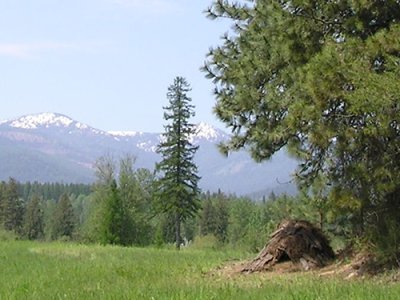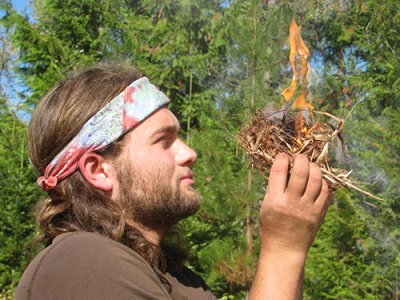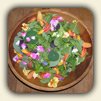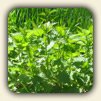Wilderness Survival Guide
I created this wilderness survival guide out of a deep passion for wilderness survival, and from a deep love for the Earth.
I have to admit it, I LOVE wilderness survival. I first began learning wilderness survival out of a deep, primal need to feel in my bones that I could provide for my most basic human needs directly from nature. It seemed crazy to me that my life was totally dependent on a complex system of grocery stores, polluted highways, telecommunication systems, electric grids, modern structures, water treatment plants, and more. I mean, shouldn't we all be able to be in direct relationship with our most primary needs? Perhaps idealistic, but that is what inspired me to begin my journey to become a wilderness survival guide over a decade ago.

Can you guess the #1 priority for survival in the wilderness?
As a wilderness survival guide, I have mentored many people in the art and science of wilderness survival. I love the answers beginners give to this question. "Water!" Nope. "Food!" No way. "Fire?" Nada. "Shelter!" Wrong again. "A good knife?" Definitely not.
It begins with looking within. It is all about who you are being. Consider the psychology of survival. Sure, most people die from exposure to the elements, but what is happening inside those people that led to their death? In short, they freaked. They strayed away from a calm center.
I love the story of the man, lost in the woods, who freaked out and began running, desperately looking for a way out. With his senses literally clouded by fear, he actually ran right across a road back into the woods to ultimately meet his death. This is certainly an extreme case, but it makes the point.
If you only remember one thing from this wilderness survival guide, it's this: The #1 wilderness survival priority is maintaining a calm center. Keeping your head on your shoulders. Staying cool. Sustaining a positive mental attitude.
Shelter
With a calm center, over half the struggle is over. As I mentioned earlier, the most common physical reason that people die in wilderness survival situations is exposure to the elements. A person can die from exposure in as little as three hours. You must learn how to stay warm when it is cold, how to stay cool when it is hot, and how to stay dry when it is wet. Enter the wilderness survival shelter. It can take many forms, with a classic one being the debris hut. The debris hut is a small, one person shelter that is basically a simple structure that cocoons a person in leaves, grasses, boughs, or other natural debris to keep them insulated. It is built to shed water. Just imagine a primitive tent and sleeping bag all in one.
Regardless of what it looks like, a wilderness survival shelter should embrace these essential principles. It should provide insulation and protection from all elements. It should include a heart source, whether that is a fire, the sun, or trapping body heat. It should be placed in a good location - think high and dry. And lastly, it should offer comfort and sanctuary. After all, this will be your new home.
Water
Staying hydrated is also a major survival priority. A person can die from dehydration in just three days. Consider that you'll be unconscious by the time you are just 7% dehydrated. Ouch.
First you'll need to find water. Water flows downhill, encourages vegetation, and collects in natural caches, be they ponds, lakes, rivers, springs, rock depressions, or even leaves. Unfortunately, most fresh water sources are not pure enough to drink from (as they used to be), so you'll need to know how to purify water under most situations. Use any of these methods to collect clean, purified water:
- You can get clean, purified water from the inside of plants like grasses, thistles, cactuses, or grapevines. You can also tap many broad leaved trees and collect their sap.
- Collect dew by using a handkerchief or bundle of dry grasses to soak up morning dew, then just wring it out.
- Use a solar still.
Fire
Most everyone loves fire. Fire is essential in a wilderness survival situation for a few reasons. One, it provides warmth which keeps body temperature up. Two, it provides heat used to purify water. It also provides light, heat to cook food, and serves as a center to draw people in. Earth based wisdom teaches us that fire is a spirit unto itself, and encourages us to have a good relationship with fire. I know that despite my passion for it, I didn't truly appreciate fire until it took me four days to get it with a fully primitive bow and drill fire making kit on my first wilderness survival solo.

There are a variety of skills to learn when it comes to fire:
- Building a fire pit
- Building a fire reflector
- Fuels
- Fire structures
- Fire tending
- Fire maintenance
- Fire making methods
- Matches - while most people assume that they know the proper way to light a match, it never ceases to amaze me how many people don't. Try this - test yourself to build and light a fire in just five minutes using only one match. Can you do it in a nearby forest? Try out different habitats. How about in the snow? In the rain?
- Flint & Steel
- Primitive Fire Making Methods - Bow Drill, Crutch Drill, Cord Drill, Hand Drill, Thong Drill, Mouth Drill, Log Drill, Spool Drill, Pump Drill, Fire Plow, Fire Saw, Fire Thong, Fire Plane, and Fire Piston. And many more.

Flint and Steel
Flint and Steel Fire Making Learn the secrets of the traditional art of making fire with a Flint and Steel kit. It is easy to learn this reliable, quick, and amazing method of making fire with flint steel!

Char Cloth
Making Char Cloth Learn how to make char cloth yourself, common mistakes to avoid, how to make fire from this amazing material, and charcloth alternatives.
Food
On average, we humans can go about three weeks without food, so this tends to be last on the wilderness survival priority list in most situations. As a wilderness survival guide, I encourage my students to connect with their hunter-gatherer ancestors. The reality is that the majority of our time on Earth, we humans have lived as hunter-gatherers. It is deep in our DNA.
Like our earth based hunter-gatherer ancestors, a good survivalist has a relationship with a wide variety of diverse species that can all serve as foods, depending on the season and location. Take a look at this wilderness survival food list to learn more.

Survival Food List
Wilderness Survival Food List An essential element of wilderness survival is knowing what to eat so you can keep yourself alive. We've got the top 133 wild foods for your survival food list right here.
Wild edible plants is a huge area of study unto itself. So much so that it goes beyond the scope of this page of our wilderness survival guide. We have devoted an entire section of our website to this study. Take a look here:

Edible Wild Plants
Discover Edible Wild Plants! 33 most common wild edible plants in N. America. Identification, ethical harvesting, processing, and eating(!) are all a part of the wild edibles experience.
Hunting, fishing, and trapping are also significant endeavors, ones that take much time and practice. These are also skills that are often times unnecessary in a short term survival situation. However if you are in a wilderness survival situation for any length of time, you'll want these skills. Throwing sticks, bow and arrow, primitive fishing, spear fishing, and primitive trapping are all important to learn.
Medicinal Plants & Herbal Remedies
If you do get hurt or sick, it is important to have a solid understanding of medicinal plants and herbal remedies. This area of study also spills outside the bounds of this page of our wilderness survival guide. Here too, we have also devoted an entire section of our website to learning this ancient art:

Online Herbal Remedies Advice
Online Herbal Remedies Advice - The Healing Power of Medicinal Plants. This is a guide to herbal remedies that includes an overview, benefits, types, best herbal remedies, and much more.
Wilderness Survival Skills vs. Wilderness Survival Gear
This wilderness survival guide wouldn't be complete without acknowledging this; hands down, skills are much more important than gear when it comes to wilderness survival. You can buy and collect all the best gear in the world, but what happens if you forget it? Or lose it? Or use it up? Then you'll be relying on yourself - your skills. With that said, it is still good to learn about wilderness survival gear and put together a wilderness survival kit. Just don't' depend on it.
Wilderness Survival Training - the best wilderness survival guide
The best way to learn and develop wilderness survival skills is to get wilderness survival training from a live wilderness survival guide or school. Twin Eagles Wilderness School offers a variety of wilderness survival training classes, including our transformational, nine month long Twin Eagles Wilderness Immersion Program - the ultimate wilderness survival training.
Wilderness Survival vs. Primitive Living
As a wilderness survival guide, I often am called upon to differentiate wilderness survival from primitive living. Often times these two are lumped together as one, but in fact they are distinct. Wilderness survival refers to the actual experience of survival in the wilderness, which may or may not be a "primitive" experience depending on the gear you have access to. Wilderness survival is usually a short term experience. Primitive Living is usually a long term experience, and refers to the experience of living in a primitive setting, practicing primitive skills for an extended period of time.
A gateway to a deeper connection
As I wrap up this wilderness survival guide, consider this. While I began my journey learning wilderness survival out of a deep, and what I now understand as an archetypal, need to be in direct relationship with my most basic needs as a human being, the learning journey itself brought many more gifts. It actually changed the way I perceived the world, bringing me to a newfound level of health and vitality, and ultimately bringing me into full connection with my passion, my power, and my purpose in life.
That is a big statement. That is also what I see so many people searching for, especially in contrast with the superficial values of our degenerative, consumeristic, capitalistic, western society. Perhaps more than anything else, wilderness survival served as the doorway to a deep and profound experience of connection, belonging, and meaning to my life. I've discovered along the way that my passion and purpose is to mentor others into that same profound sense of connection, belonging, and meaning that comes through wilderness survival and deep nature connection, ultimately guiding them to their deepest calling.
For this I give thanks.
Interested in being personally mentored in Wilderness Survival & Primitive Skills, on a transformational journey of connection to nature, community, and self?
Check out the Twin Eagles Wilderness Immersion Program.
comments powered by Disqus
Return from Wilderness Survival Guide to Wilderness Survival (homepage)
Track Us